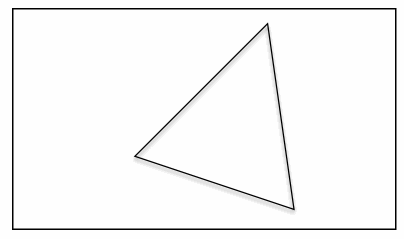Geometry Challenge: Drawing Polygons in a Rectangle

We are given a rectangle with dimensions , where and are positive real numbers and . In this note, we will try to find the area of the largest regular polygons that can be drawn completely inside the rectangle.
A shape is said to be drawn completely inside the rectangle if no point of the shape is outside the rectangle.
What is the area of the largest regular quadrilateral that can be drawn completely inside the rectangle?
What is the area of the largest regular triangle that can be drawn completely inside the rectangle?
What is the area of the largest regular hexagon that can be drawn completely inside the rectangle?
Prove (or disprove): The largest possible regular -gon that can be drawn completely in the rectangle is drawn. If is even, then two opposite sides of the -gon will lie on longer sides of the rectangle.
Prove (or disprove) : There exists a general formula to calculate the area of the largest regular -gon that can be drawn completely inside the rectangle in terms of and .
If such a formula exists, find it.
Easy Math Editor
This discussion board is a place to discuss our Daily Challenges and the math and science related to those challenges. Explanations are more than just a solution — they should explain the steps and thinking strategies that you used to obtain the solution. Comments should further the discussion of math and science.
When posting on Brilliant:
*italics*or_italics_**bold**or__bold__paragraph 1
paragraph 2
[example link](https://brilliant.org)> This is a quote# I indented these lines # 4 spaces, and now they show # up as a code block. print "hello world"\(...\)or\[...\]to ensure proper formatting.2 \times 32^{34}a_{i-1}\frac{2}{3}\sqrt{2}\sum_{i=1}^3\sin \theta\boxed{123}Comments
Level 5: I think formula is 4nω2tan(nπ) for even .I m not sure coz i calculated it orally so i could have missed something conceptually too.
For odd: 2(1+cos(nπ))2nω2sin(n2π)
Log in to reply
Hmm, something is not right. Your formulae are independent of l. However, the final result does depend on l. You may try the level 2 problem first to see the dependence on l.
Could you elaborate on how you obtained these formulae? Thanks.
Log in to reply
Hey can u tell me how even one will depend on l.
This can be extended to general .Let there be n sides so angle subtented at centre will be n2π Let the Longest diagnol be D and it also makes an angle a with vertical .Hence Dcosa=w.Now area of one triangle
=2(D/2)2Sin(2π/n)
So n triangles area= 8nd2Sin(n2π)= 8cos2(a)nw2Sin(n2π)
similarily max value of total area will occur at a=π/n because cos is a decreasing function and after π/n figure will come out of rectangle and also 2 opp sides will be on longer sides of rectangle. Simplifying it we get the formula i stated below for even. Note i have taken two points on longer opp sides to generalise and then shown for max that two sides of polygon have to be on two longer sides of rectangle.
Note i have taken two points on longer opp sides to generalise and then shown for max that two sides of polygon have to be on two longer sides of rectangle.
can u please tell why it will depend on l
Log in to reply
Your reasoning is correct for a square. In a square, a should be 45∘. Area of square will be 2cos2aw2=w2, and it will not depend on l. However, this reasoning does not extend for other n.
Consider a hexagon. Following the same reasoning, the longest diagonal will make an angle π/6 with the vertical. The length of one side of the hexagon will be 3w. The width of the hexagon will be 32w. If l>32w, then area does not depend on l. However, if l is less than 32w, then some of the hexagon will go out of the rectangle, then the area does depend on l.
Log in to reply
OOps!correct I think i should sleep .I m sickk
Log in to reply
Nice efforts though!